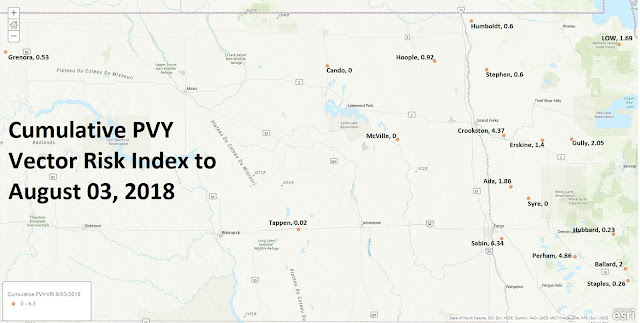Trap Catches Identified to September 14th
Greetings!
Trap catches are decreasing rapidly with only 25 aphids captured this week, 13 of which were vector species, recovered from 5 locations reporting. This will likely be the last week of traps reporting.
One Green Peach Aphid was recovered from Humboldt, the rest of the sites reporting few if any vector species.
One Green Peach Aphid was recovered from Humboldt, the rest of the sites reporting few if any vector species.
We'll put up a season summary next week.
Good luck to those of you who are beginning to harvest!
Good luck to those of you who are beginning to harvest!
The PVY Risk Index Index Not all species of aphid are equally efficient at transmitting PVY, some are better than others (green peach being the most efficient vector of PVY). So, the total number of aphids in a trap don't necessarily reflect just how much vector pressure there is at that location. The PVY Vector Risk Index compares aphid numbers, incorporating their relative vector efficiency compared to the Queen of PVY vectors (green peach aphid!). Using averaged reference comparisons from the literature, we multiply the number of each aphid species captured by its efficiency compared to Green Peach Aphid to more accurately depict risk posed by the species being trapped. We then sum the totals. The PVY-VRI values are presented on the tables below but also on maps comparing current cumulative risk to the total risk from the sample sites of last year (to compare with your local winter grow out results).
Cumulative PVY Vector Risk Index Map to September 14th, 2018
Cumulative PVY Vector Risk Index Map for 2017
(included for comparison)
Aphid Species Capture + PVY Risk - Week of September 8-14th, 2018
Total PVY Risk and Species Capture to September 14th, 2018





























